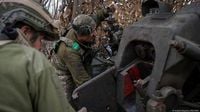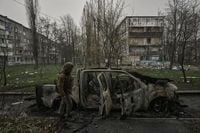In a stark escalation of hostilities in eastern Ukraine, President Volodymyr Zelenskyy announced on October 31, 2025, that Russia has amassed approximately 170,000 troops in the Donetsk region, with a concentrated effort to seize the embattled city of Pokrovsk. The Ukrainian leader described the situation as “difficult,” noting that although some Russian units have infiltrated Pokrovsk, Ukrainian defenders are actively working to repel and "gradually destroy" them. Zelenskyy emphasized, "There are Russians in Pokrovsk. Our guys are destroying them, destroying them little by little — because we also have to protect our personnel," according to coverage by the Kyiv Independent and the Associated Press.
The scale of the Russian offensive is daunting. Zelenskyy revealed that Russian forces now outnumber Ukrainian troops in the area by as much as eight-to-one, a margin that has placed enormous pressure on Ukraine’s defenders. Despite Russian claims of encirclement, Ukrainian forces still maintain a narrow corridor—just over 10 kilometers wide—allowing for the flow of reinforcements and supplies into Pokrovsk. The Ukrainian military, as cited by open-source monitoring group DeepState, reports that Russian troops are intensifying efforts to close this gap, aiming to completely encircle the city by advancing from the northwest and north.
Russian President Vladimir Putin, meanwhile, has touted his military’s progress and sought to convince international observers, particularly the United States, that Ukraine cannot withstand Russia’s military might. He has also highlighted Russia’s advancing nuclear capabilities and reiterated his country’s war aims, refusing to yield to Western calls for a negotiated peace.
On the ground, the fighting has been relentless. The Ukrainian General Staff reported on October 31 that Russia has lost over 1.1 million troops since the start of the full-scale invasion in February 2022, along with thousands of tanks, armored vehicles, and drones. Yet, Russia’s numerical superiority in Donetsk is undeniable, and Ukrainian officials have not ruled out the possibility of a tactical withdrawal to preserve their forces, a strategy they have employed in past sieges.
As Russian forces push forward, Ukraine has ramped up its campaign to strike targets deep inside Russian territory. Since the beginning of 2025, Ukrainian forces have conducted more than 160 long-range attacks on Russian oil extraction and refining facilities, according to Vasyl Maliuk, head of Ukraine’s Security Service. In September and October alone, 20 such strikes were carried out, reportedly causing a 20% drop in oil products on Russia’s domestic market and temporarily halting 37% of the country’s refining capacity. Maliuk stated, "Clearly, we are not resting on our achievements. There are many fresh perspectives and new approaches in this work. These include new equipment, new combat units, and new methods and means of communication."
Ukraine’s domestically produced Neptune cruise missiles have played a pivotal role in these operations. On October 31, the Ukrainian Navy confirmed strikes on the Oryol Thermal Power Plant and the Novobryansk electrical substation in Russia’s Oryol Oblast. Both facilities supplied power to military-industrial plants in the region, and their destruction "dealt a serious blow to the occupiers’ logistics," the Navy reported.
In addition to targeting energy infrastructure, Ukraine’s Special Operations Forces claimed responsibility for destroying a Russian Buk-M3 air defense system and a Nebo-U radar in Russia’s Rostov Oblast. The Buk-M3 can strike targets up to 80 kilometers away, while the Nebo-U radar can detect fighter jets within a 400-kilometer radius. The Ukrainian SSO noted that these systems posed significant threats to Ukrainian aviation and deep strike capabilities, and each system is valued at "hundreds of millions of dollars."
Perhaps most notably, President Zelenskyy revealed that Ukrainian security services destroyed a Russian Oreshnik ballistic missile at the Kapustin Yar missile range in Russia’s Astrakhan Oblast during the summer of 2024. The Oreshnik, first used by Russia in a November 2024 strike on Dnipro, boasts a range of up to 5,000 kilometers and a 700-kilometer dead zone. Zelenskyy warned, "Our partners in Europe should pay attention to this," highlighting the missile’s strategic reach and the fact that Russia can produce up to six per year.
The conflict’s toll on civilians has grown increasingly severe. The United Nations reported a 30% rise in Ukrainian civilian casualties in 2025 compared to the previous year. Russian drone attacks continue to batter Ukrainian cities, with a recent assault on apartment blocks in Sumy injuring 11 people, including four children, and further strikes targeting energy infrastructure in the Odesa region. Over the past day alone, at least 14 people were killed and 71 wounded across Ukraine, according to local authorities cited by the Kyiv Independent.
Matthias Schmale, the UN Humanitarian Coordinator in Ukraine, voiced urgent concerns about Russia’s near-daily attacks on energy production and distribution facilities. With a colder winter looming, the risk to centralized public infrastructure—essential for water, sewage, and heating in high-rise buildings—could "turn into a major crisis," Schmale warned. He described the destruction of energy infrastructure as a "form of terror" that directly impacts the civilian population.
Compounding the humanitarian crisis, the UN’s funding for Ukraine has plummeted from over $4 billion in 2022 to just $1.1 billion in 2025. This shortfall has hampered the organization’s ability to respond to acute needs as the war drags on. Schmale observed, "We have been through phases this year where there was cautious optimism that it might end. Right now on the ground, it doesn’t feel at all like it’s ending any time soon."
Amid the chaos, disturbing reports have emerged of extrajudicial killings and torture within the Russian military ranks. An investigation by Russian independent outlet Verstka uncovered a practice known as "nullifying," where senior officers reportedly send their own soldiers on deadly missions without adequate protection, effectively executing targeted personnel. One soldier, Dmitry, told investigators, "You never know where the bullet will come from: from your own side or from the Ukrainians."
The use of advanced weaponry has also shifted the strategic landscape. Reuters reported that Russia’s 9M729 ground-launched cruise missile—whose development prompted the U.S. withdrawal from the Intermediate-Range Nuclear Forces (INF) Treaty in 2019—has been fired at Ukraine multiple times, with a range recorded at up to 1,200 kilometers. This development has further complicated the security calculus for both Ukraine and NATO allies.
As winter approaches and the front lines shift, the battle for Pokrovsk has become a microcosm of the wider war: a test of endurance, innovation, and resolve. With both sides deploying new tactics and technologies, and civilians increasingly caught in the crossfire, the prospect of a swift resolution appears more distant than ever.


